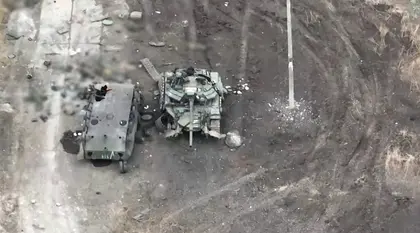Russian troops involved in Moscow’s disastrous attempt to retake the Ukrainian town of Avdiivka were sent into battle in obsolete, 70-year-old vehicles, photos of the battle wreckage suggest.
Independent open-source analysts have recorded at least one destroyed BTR-50, a Soviet-era armored personnel carrier (APC) developed in 1952. Production of the vehicle stopped in 1970.
JOIN US ON TELEGRAM
Follow our coverage of the war on the @Kyivpost_official.
#Ukraine: The first confirmed loss of a Russian BTR-50 APC- this one was destroyed during the ongoing offensive on Avdiivka, #Donetsk Oblast. A damaged T-64BV can be seen nearby too.
— 🇺🇦 Ukraine Weapons Tracker (@UAWeapons) October 14, 2023
The Russian troops started to receive these rather old APCs in February of this year. pic.twitter.com/MdLoTJtVNl
The BTR-50 is thinly armored by modern standards, protected by at most 13 millimeters of cold-welded steel, insufficient protection from modern anti-tank weapons. And its flat hull does nothing to deflect blasts from mines.
Modern APCs usually combine a steel hull with modular composite armor and have a V-shaped hull to deflect mine blasts.
The fact that the BTR-50 spotted near Avdiivka is upside down with a large hole visible suggests it may have hit a mine. The fate of its occupants – it can carry up to 20 troops – is unknown, but given the damage, the prognosis isn’t positive.
The BTR-50 saw notable service in the 1967 Six-Day War and the 1973 Yom Kippur War, both pitting Israel against surrounding Arab states that were supplied by the Soviet Union.
The Soviet Union and then Russia developed more modern APCs in subsequent years, but as the war in Ukraine dragged on and Moscow’s materiel losses mounted, the Kremlin has increasingly had to rely on outdated military vehicles and tanks to plug the gaps.

Ukraine Says Russia Provides North Korean Troops Fake Russian Military IDs
BTR-50s were spotted being dragged out of storage back in May when it was assumed they would only be used in supportive roles rather than in assaults.
#Ukraine/#Russia 🇺🇦🇷🇺:
— 𝕻𝖗𝖆𝖎𝖘𝖊 𝕿𝖍𝖊 𝕾𝖙𝖊𝖕𝖍 (@praisethesteph) May 10, 2023
Two 🇷🇺#Russian BTR-50PK & BTR-50PU APCs armed with 23mm ZU-23-2 autocannon heading to the front.
Although these APCs are obsolete (they entered service in 1954), they will play a rather supportive role, and in combination with the 23mm autocannon they are… pic.twitter.com/E1aBxJxvjX
The Kremlin launched an attempted encirclement operation against the town of Avdiivka in early October.
This ended in severe defeat for Russian forces attacking in massed armored columns against Ukrainian troops in well-established fortifications, backed by artillery and anti-tank missile batteries.
Kyiv Post reported a severe Russian defeat in the area on Oct. 13.
Accumulated counts of Russian armored vehicles confirmed to have been knocked out, burnt, or otherwise put out of action by modified non-military drones totaled 428 pieces of Russian army heavy equipment, including 75 tanks, 88 infantry fighting vehicles and armored personnel carriers, and 163 artillery pieces.
Ukrainian officials on Monday noted a lull in the fighting around Avdiivka but warned it was not expected to last.
Vitaliy Barabash, head of Avdiivka’s military administration, told Ukrainian TV: “Shelling has diminished, there was less today. We expect there will be new waves of heavy attacks in the days to come.”
The Institute for the Study of War (ISW) reported on Monday that Russia “likely” deployed at least two Central Military District (CMD) brigades to support the local and often disgruntled Donetsk People’s Republic (DNR) volunteer forces on the Avdiivka front, as stepped-up Russian airstrikes generally replaced ground maneuvers.
A Ukrainian military blogger noted on Monday that the CMD’s 15th and 21st MRBs (both of the 2nd Combined Arms Army) have joined the DNR’s 114th Motorized Rifle Brigade in the fighting near Avdiivka, alongside “various scattered DNR elements, while Russian forces are holding the CMD’s 30th MRB in tactical reserve.”
These reinforcement units had been observed holding the Svatove-Kreminna line until recently, ISW analysts noted, highlighting that these Russian reinforcements had been taking more passive, “defensive” positions there for the last several months and “have therefore likely had more time to rest and reconstitute.”
On Monday, Russian forces made some gains near Avdiivka “at a relatively slower pace than in the initial attacks,” the ISW noted. Geolocated footage posted on Monday shows that Russian forces have marginally advanced past the E50 road about 3 km south of Avdiivka.
The AFU (Armed Forces of Ukraine) General Staff also registered “notably fewer” infantry attacks that had occurred over the weekend. Instead, Russian forces reportedly have increased the intensity of air and artillery strikes “in order to compensate for slow ground maneuvers,” the ISW analysts wrote.
You can also highlight the text and press Ctrl + Enter






